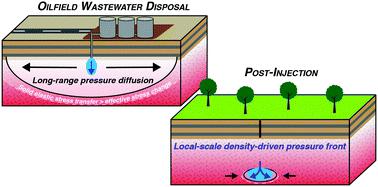当前位置:
X-MOL 学术
›
Energy Environ. Sci.
›
论文详情
Our official English website, www.x-mol.net, welcomes your
feedback! (Note: you will need to create a separate account there.)
A new perspective on the hydraulics of oilfield wastewater disposal: how PTX conditions affect fluid pressure transients that cause earthquakes
Energy & Environmental Science ( IF 32.4 ) Pub Date : 2020-08-05 , DOI: 10.1039/d0ee01864c Ryan M. Pollyea 1, 2, 3, 4 , Graydon L. Konzen 1, 2, 3, 4 , Cameron R. Chambers 1, 2, 3, 4 , Jordan A. Pritchard 1, 2, 3, 4 , Hao Wu 1, 2, 3, 4 , Richard S. Jayne 1, 2, 3, 4
Energy & Environmental Science ( IF 32.4 ) Pub Date : 2020-08-05 , DOI: 10.1039/d0ee01864c Ryan M. Pollyea 1, 2, 3, 4 , Graydon L. Konzen 1, 2, 3, 4 , Cameron R. Chambers 1, 2, 3, 4 , Jordan A. Pritchard 1, 2, 3, 4 , Hao Wu 1, 2, 3, 4 , Richard S. Jayne 1, 2, 3, 4
Affiliation

|
Pumping oilfield wastewater into deep injection wells causes earthquakes by effective stress change and solid elastic stressing. These processes result from fluid pressure changes in the seismogenic basement, so it is generally accepted that pressure diffusion governs spatiotemporal patterns of induced earthquake sequences. However, new evidence suggests that fluid density contrasts may also drive local-scale (near-well) pressure transients to greater depths than pressure diffusion and over much longer timescales. As a consequence, the pressure, temperature, and composition (PTX) conditions of wastewater and deep crustal (basement) fluids may be fundamental to understanding and managing injection-induced seismicity. This study develops a mechanistic framework that integrates PTX-dependent fluid properties into the generally accepted conceptual model of injection-induced seismicity. Nonisothermal variable-density numerical simulation is combined with ensemble simulation methods to isolate the parametric controls on injection-induced fluid pressure transients. Results show that local-scale, density-driven pressure transients are governed by a combination of fracture permeability and PTX-dependent fluid properties, while long-range pressure diffusion is largely governed by fracture permeability. Considering this new conceptual model in the context geochemical data from oil and gas basins in the United States identifies regions that may be susceptible to persistent density-driven pressure transients.
中文翻译:

油田废水处理水力学的新观点:PTX条件如何影响引起地震的流体瞬变
将油田废水泵入深注入井,会因有效应力变化和固体弹性应力而引起地震。这些过程是由地震基底中的流体压力变化引起的,因此,通常认为压力扩散控制着诱发地震序列的时空分布。然而,新的证据表明,流体密度对比还可能将局部尺度(近井)压力瞬变驱动到比压力扩散更大的深度,并持续更长的时间尺度。结果,废水和深地壳(地下)流体的压力,温度和组成(PTX)条件可能是理解和管理注入诱发地震活动的基础。这项研究开发了一个机械框架,该框架将依赖PTX的流体特性整合到了普遍接受的注入诱发地震活动性概念模型中。非等温变密度数值模拟与整体模拟方法相结合,以隔离注入引起的流体压力瞬变的参数控制。结果表明,局部尺度,密度驱动的压力瞬变受裂缝渗透率和PTX依赖的流体性质的共同影响,而远距离压力扩散很大程度上受裂缝渗透率的影响。考虑到来自美国油气盆地的地球化学数据的背景下的这一新概念模型,确定了可能容易受到持久性密度驱动的压力瞬变影响的区域。非等温变密度数值模拟与整体模拟方法相结合,以隔离注入引起的流体压力瞬变的参数控制。结果表明,局部尺度,密度驱动的压力瞬变受裂缝渗透率和PTX依赖的流体性质的共同影响,而远距离压力扩散很大程度上受裂缝渗透率的影响。考虑到来自美国油气盆地的地球化学数据的背景下的这一新概念模型,确定了可能容易受到持久性密度驱动的压力瞬变影响的区域。非等温变密度数值模拟与整体模拟方法相结合,以隔离注入引起的流体瞬变的参数控制。结果表明,局部尺度,密度驱动的压力瞬变受裂缝渗透率和依赖PTX的流体性质的共同作用所控制,而远距离压力扩散很大程度上受裂缝渗透率的影响。考虑到来自美国油气盆地的地球化学数据的背景下的这一新概念模型,确定了可能容易受到持久性密度驱动的压力瞬变影响的区域。密度驱动的压力瞬变是由裂缝渗透率和PTX依赖的流体性质共同决定的,而远距离压力扩散主要由裂缝渗透率决定。考虑到来自美国油气盆地的地球化学数据的背景下的这一新概念模型,确定了可能容易受到持久性密度驱动的压力瞬变影响的区域。密度驱动的压力瞬变受裂缝渗透率和依赖于PTX的流体性质的共同作用所控制,而远距离压力扩散很大程度上受裂缝渗透率的影响。考虑到来自美国油气盆地的地球化学数据的背景下的这一新概念模型,确定了可能容易受到持久性密度驱动的压力瞬变影响的区域。
更新日期:2020-09-16
中文翻译:

油田废水处理水力学的新观点:PTX条件如何影响引起地震的流体瞬变
将油田废水泵入深注入井,会因有效应力变化和固体弹性应力而引起地震。这些过程是由地震基底中的流体压力变化引起的,因此,通常认为压力扩散控制着诱发地震序列的时空分布。然而,新的证据表明,流体密度对比还可能将局部尺度(近井)压力瞬变驱动到比压力扩散更大的深度,并持续更长的时间尺度。结果,废水和深地壳(地下)流体的压力,温度和组成(PTX)条件可能是理解和管理注入诱发地震活动的基础。这项研究开发了一个机械框架,该框架将依赖PTX的流体特性整合到了普遍接受的注入诱发地震活动性概念模型中。非等温变密度数值模拟与整体模拟方法相结合,以隔离注入引起的流体压力瞬变的参数控制。结果表明,局部尺度,密度驱动的压力瞬变受裂缝渗透率和PTX依赖的流体性质的共同影响,而远距离压力扩散很大程度上受裂缝渗透率的影响。考虑到来自美国油气盆地的地球化学数据的背景下的这一新概念模型,确定了可能容易受到持久性密度驱动的压力瞬变影响的区域。非等温变密度数值模拟与整体模拟方法相结合,以隔离注入引起的流体压力瞬变的参数控制。结果表明,局部尺度,密度驱动的压力瞬变受裂缝渗透率和PTX依赖的流体性质的共同影响,而远距离压力扩散很大程度上受裂缝渗透率的影响。考虑到来自美国油气盆地的地球化学数据的背景下的这一新概念模型,确定了可能容易受到持久性密度驱动的压力瞬变影响的区域。非等温变密度数值模拟与整体模拟方法相结合,以隔离注入引起的流体瞬变的参数控制。结果表明,局部尺度,密度驱动的压力瞬变受裂缝渗透率和依赖PTX的流体性质的共同作用所控制,而远距离压力扩散很大程度上受裂缝渗透率的影响。考虑到来自美国油气盆地的地球化学数据的背景下的这一新概念模型,确定了可能容易受到持久性密度驱动的压力瞬变影响的区域。密度驱动的压力瞬变是由裂缝渗透率和PTX依赖的流体性质共同决定的,而远距离压力扩散主要由裂缝渗透率决定。考虑到来自美国油气盆地的地球化学数据的背景下的这一新概念模型,确定了可能容易受到持久性密度驱动的压力瞬变影响的区域。密度驱动的压力瞬变受裂缝渗透率和依赖于PTX的流体性质的共同作用所控制,而远距离压力扩散很大程度上受裂缝渗透率的影响。考虑到来自美国油气盆地的地球化学数据的背景下的这一新概念模型,确定了可能容易受到持久性密度驱动的压力瞬变影响的区域。











































 京公网安备 11010802027423号
京公网安备 11010802027423号